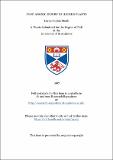Post-anoxic injury in higher plants
Abstract
The perennating organ, the rhizome, was chosen for examination of response to anoxia in monocotyledonous species known to differ in tolerance of flooding. Survival of prolonged anoxia was monitored in the wetland species (Acorus calamus, Iris pseudacorus. Phragmites australis, Schoenoplectus lacustris and Typha latifolia), and the dryland species (Iris germanica). Fermentation capacity was estimated in the anoxic and post-anoxic phases together with ethanol and lactate accumulation. Under N2 accumulation of ethanol took place in all species; lactic fermentation was of less importance. There was a steady-state condition of low ethanol accumulation in the wetland species, where an apparent equilibrium of production and elimination from rhizome tissue was reached. In contrast, the dryland species showed a continuous increase in ethanol accumulation during oxygen deprivation. Catalase and superoxide dismutase activities were measured during the post-anoxic recovery phase in their role as enzymatic defences against oxygen toxicity. In rhizomes of the anoxia tolerant species A. calamus. S. lacustris and I. pseudacorus, no changes in catalase activity were observed. However, the relatively anoxia intolerant Glyceria maxima, Juncus effusus and I.germanica exhibited significant increases in catalase activity. To investigate whether catalase (acting in its 'peroxidatic' mode) was perhaps here involved in an ethanol oxidation reaction, anaerobic rhizomes of G.maxima were exposed to ethanol vapour: considerable increases in catalase activity were recorded. It is proposed that acetaldehyde thus produced may be a source of post-anoxic injury. Superoxide dismutase activity in I.pseudacorus rhizomes rose significantly during anoxia, while small increases were found in the less anoxia tolerant I.germanica and a drop in activity was recorded in G.maxima. It is suggested that I.pseudacorus may be less susceptible to post-anoxic injury by means of oxygen toxicity, while in the other species oxidative damage on return to air may contribute to anoxia intolerance.
Type
Thesis, PhD Doctor of Philosophy
Collections
Items in the St Andrews Research Repository are protected by copyright, with all rights reserved, unless otherwise indicated.

